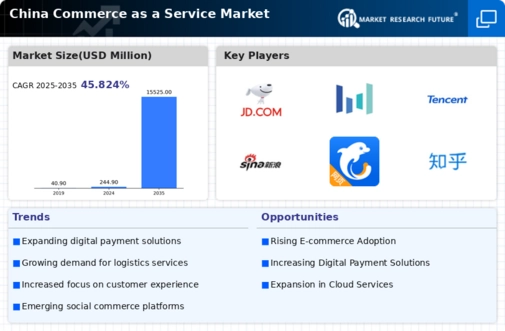Growing Demand for Customization
The commerce as-a-service market in China experiences a notable surge in demand for personalized shopping experiences. Consumers increasingly seek tailored products and services, prompting businesses to adopt flexible solutions that cater to individual preferences. This trend is reflected in the rise of platforms that allow for product customization, which has been reported to enhance customer satisfaction and loyalty. In 2025, the market for personalized commerce solutions is projected to reach approximately $10 billion, indicating a robust growth trajectory. Companies that leverage data analytics to understand consumer behavior are likely to thrive in this evolving landscape, as they can offer targeted marketing and product recommendations. This growing demand for customization is a key driver for the commerce as-a-service market, as it compels service providers to innovate and adapt their offerings to meet consumer expectations.
Expansion of Digital Payment Solutions
The proliferation of digital payment methods significantly influences the commerce as-a-service market in China. With the increasing adoption of mobile wallets and contactless payment systems, consumers are more inclined to engage in online transactions. In 2025, it is estimated that over 70% of online purchases will be made through digital payment platforms, reflecting a shift in consumer behavior towards convenience and security. This trend encourages businesses to integrate diverse payment options into their commerce as-a-service solutions, thereby enhancing user experience and reducing cart abandonment rates. Furthermore, the Chinese government has been supportive of digital payment innovations, which fosters a conducive environment for the growth of the commerce as-a-service market. As a result, companies that prioritize seamless payment integration are likely to gain a competitive edge in this dynamic market.
Emergence of Omnichannel Retail Strategies
The shift towards omnichannel retailing is a pivotal driver for the commerce as-a-service market in China. Consumers now expect a seamless shopping experience across various channels, including online, mobile, and physical stores. This trend necessitates that businesses adopt integrated solutions that unify their sales and marketing efforts. In 2025, it is projected that companies employing omnichannel strategies could see a revenue increase of up to 30%, as they cater to the diverse preferences of consumers. By providing a cohesive shopping experience, businesses can enhance customer loyalty and retention. The emergence of omnichannel retail strategies compels service providers in the commerce as-a-service market to innovate and develop solutions that facilitate cross-channel interactions, thereby positioning themselves favorably in a competitive landscape.
Increased Focus on Supply Chain Efficiency
Efficiency in supply chain management is becoming increasingly critical for businesses operating within the commerce as-a-service market in China. As competition intensifies, companies are compelled to streamline their operations to reduce costs and improve service delivery. The integration of advanced logistics solutions and real-time inventory management systems is essential for achieving these objectives. In 2025, it is projected that companies that optimize their supply chains could see a reduction in operational costs by up to 15%. This focus on efficiency not only enhances profitability but also improves customer satisfaction by ensuring timely delivery of products. Consequently, businesses that invest in innovative supply chain technologies are likely to drive growth within the commerce as-a-service market, as they can offer more reliable and responsive services to their customers.
Rising Adoption of Artificial Intelligence
The incorporation of artificial intelligence (AI) technologies is transforming the commerce as-a-service market in China. AI-driven solutions enable businesses to analyze vast amounts of consumer data, facilitating more informed decision-making and personalized marketing strategies. In 2025, it is anticipated that AI applications in commerce could enhance operational efficiency by approximately 20%, allowing companies to better anticipate consumer needs and preferences. This technological advancement not only streamlines operations but also enhances customer engagement through personalized experiences. As businesses increasingly recognize the potential of AI to drive growth and innovation, the demand for AI-integrated commerce as-a-service solutions is expected to rise. This trend indicates a shift towards more intelligent and adaptive commerce platforms that can respond dynamically to market changes.

















Leave a Comment